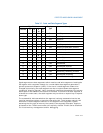
Vol. 3 3-21
PROTECTED-MODE MEMORY MANAGEMENT
Each system must have one GDT defined, which may be used for all programs and
tasks in the system. Optionally, one or more LDTs can be defined. For example, an
LDT can be defined for each separate task being run, or some or all tasks can share
the same LDT.
The GDT is not a segment itself; instead, it is a data structure in linear address space.
The base linear address and limit of the GDT must be loaded into the GDTR register
(see
Section 2.4, “Memory-Management Registers”). The base addresses of the GDT
should be aligned on an eight-byte boundary to yield the best processor perfor-
mance. The limit value for the GDT is expressed in bytes. As with segments, the limit
value is added to the base address to get the address of the last valid byte. A limit
value of 0 results in exactly one valid byte. Because segment descriptors are always
8 bytes long, the GDT limit should always be one less than an integral multiple of
eight (that is, 8N – 1).
The first descriptor in the GDT is not used by the processor. A segment selector to
this “null descriptor” does not generate an exception when loaded into a data-
segment register (DS, ES, FS, or GS), but it always generates a general-protection
exception (#GP) when an attempt is made to access memory using the descriptor. By
initializing the segment registers with this segment selector, accidental reference to
unused segment registers can be guaranteed to generate an exception.
The LDT is located in a system segment of the LDT type. The GDT must contain a
segment descriptor for the LDT segment. If the system supports multiple LDTs, each
must have a separate segment selector and segment descriptor in the GDT. The
segment descriptor for an LDT can be located anywhere in the GDT. See
Section 3.5,
“System Descriptor Types”, information on the LDT segment-descriptor type.
An LDT is accessed with its segment selector. To eliminate address translations when
accessing the LDT, the segment selector, base linear address, limit, and access rights
of the LDT are stored in the LDTR register (see
Section 2.4, “Memory-Management
Registers”).
When the GDTR register is stored (using the SGDT instruction), a 48-bit “pseudo-
descriptor” is stored in memory (see top diagram in
Figure 3-11). To avoid alignment
check faults in user mode (privilege level 3), the pseudo-descriptor should be located
at an odd word address (that is, address MOD 4 is equal to 2). This causes the
processor to store an aligned word, followed by an aligned doubleword. User-mode
programs normally do not store pseudo-descriptors, but the possibility of generating
an alignment check fault can be avoided by aligning pseudo-descriptors in this way.
The same alignment should be used when storing the IDTR register using the SIDT
instruction. When storing the LDTR or task register (using the SLTR or STR instruc
-
tion, respectively), the pseudo-descriptor should be located at a doubleword address
(that is, address MOD
4 is equal to 0).


















